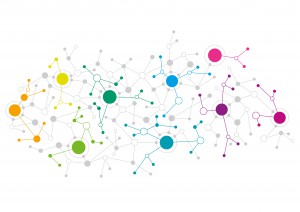While recently watching a great video series featuring supply chain leaders from companies like Roland DG, Merck, Schneider Electric, TrinityRail, and more, one thing really stood out. The value of connecting the dots.
While connecting the multitude of dots in your value chain may seem like an insurmountable task, rest assured it can be done—and without pulling out all your hair in the process! These global enterprise companies are proof of that. But don't let growing complexity in your own supply chain keep you from trying. By developing more agile processes and a better picture of your end-to-end supply chain, you’ll be able to quickly and confidently make the necessary decisions to support your business’s corporate goals. What does it mean to connect the dots? Connecting the dots means being able to draw a continuous line from one end of your supply chain all the way to the other—from customers to as far down the supplier network as you can get. It’s a complete look at both your upstream and downstream nodes, and also includes all your internal data steams coming from existing ERPs, distribution centers, factories, etc. But be warned, this isn’t about a one-way flow of information. Your relationship with your suppliers and customers should be symbiotic, with information passing freely back and forth, feeding into the same data pool—the same version of the truth—to ensure everything is on track and running smoothly, or provide the necessary details to analyze and course correct if it’s not. What’s the value in connecting the dots? By connecting all the various dots in your supply chain, you gain enhanced visibility, which in turn means you’ll be able to spot problems, or opportunities, that much faster. Say one of your suppliers is experiencing a temporary disruption due to unforeseen circumstances. You’ll know sooner there’s a potential issue. And since you’ll already have near real-time data easily available, not only orders tied to that specific supplier but all others as well, you’ll be able to act faster in running scenario simulations to determine how best to proceed. In the event you need to delay an order, you’ll also be able to let the customer know earlier, and give a more accurate estimate for when items will be received. For Schneider Electric, that upstream and downstream agility meant confidence in the face of a potential crisis. In 2011 when a 9.0 magnitude earthquake devastated Japan, Schneider Electric faced a top line sales risk of €1.5 billion. More than 50% of their key suppliers were based in the region. By leveraging their collaborative planning model, Schneider Electric was able to mitigate the risk and change course quickly, ensuring virtually no customer disruptions occurred. But the benefits aren’t only realized during disasters. For TrinityRail, demand is incredibly difficult to forecast thanks to their made to order environment. The freight railcars they produce are configured to each customer’s unique and exacting specifications. Each of these multiple car types have relatively independent business cycles. Having the available capacity to meet demand in customer lead times requirements became critical to winning orders. In order to meet the challenges of this highly complex environment, they adopted a sense and respond supply chain strategy. Instead of trying to optimize their planning, they quickly realized being able to react faster would better suit their business needs. They even eliminated forecasting altogether. In order to make that move successful, they relied heavily on visibility and collaboration—both achieved through connecting the dots of their supply chain! How can you connect the dots? Now that we’ve established the value of connecting the dots of your supply chain, the question becomes how you can actually do it. For Roland DG, it started with finding the right technology partner. Their requirements included the ability to join their global organization together, while also connecting the whole supply chain end-to-end from manufacturing to customers. This meant technology with the capability to concurrently and continuously plan, monitor and respond in a single environment and across business functions. They opted to move forward with an agile deployment of Kinaxis’ RapidResponse® solution. Working collaboratively, Roland DG was able to begin the ongoing process of connecting all their fragmented planning centers together, which will ultimately lead to transforming into a more customer-centric organization. Merck also utilized RapidResponse to connect all the nodes of their supply chain, preventing each one from continuing to work in isolation. This has allowed the opportunity to drive true customer demand through the entire supply chain, right down to manufacturers and suppliers. The result is the ability to respond faster to customer needs. But for Merck, it wasn’t just about the technology. It was about a fundamental shift in the corporate mindset. Increasing user adoption and focusing on proactive instead of reactive supply chain management became a priority for everyone, from the executive level to the supply chain practitioners. It’s that harmonization between people, process and technology that allows true potential to be realized when connecting the dots of your supply chain. Interested in learning more about how global enterprises are transforming their supply chains? Check out our leadership video series.© Kinaxis Inc. 2024. All Rights Reserved.





Leave a Reply